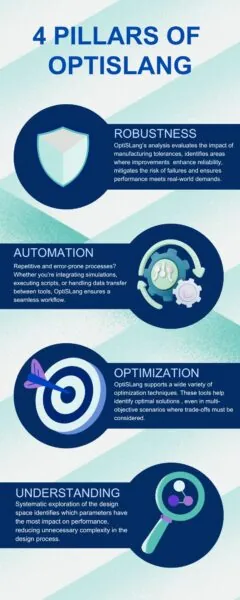Mastering Simulation and Optimization with Ansys OptiSLang: A Comprehensive Guide

In the ever-evolving field of engineering and simulation, tools like Ansys OptiSLang are revolutionizing how we approach process integration and design optimization. OptiSLang, part of the Ansys software suite, serves as a strong platform for automating workflows, exploring design spaces, optimizing parameters, and ensuring robustness in product design. Here, we explore its capabilities and why it has become an essential tool for engineers and designers worldwide.
 OptiSLang’s functionality can be grouped into four key pillars: automation, design understanding, optimization, and robustness. Each contributes to streamlining the design and development process while enhancing accuracy and efficiency.
OptiSLang’s functionality can be grouped into four key pillars: automation, design understanding, optimization, and robustness. Each contributes to streamlining the design and development process while enhancing accuracy and efficiency.
One of OptiSLang’s standout features is its ability to integrate seamlessly with a wide range of tools and processes. It connects effortlessly with Ansys solvers, third-party tools like MATLAB and Excel, and even custom solvers that rely on text-based input and output. This flexibility makes it an invaluable resource for engineers who work with diverse software ecosystems.
Moreover, OptiSLang supports parallel processing, allowing simulations to run concurrently. This feature significantly reduces computation times, especially when handling large-scale simulations on high-performance computing (HPC) clusters. For example, with a single premium license, users can run multiple solvers simultaneously, maximizing hardware utilization.
OptiSLang’s sensitivity analysis capabilities allow engineers to explore complex design spaces methodically. By utilizing Design of Experiments (DOE) sampling techniques, it ensures efficient coverage of the design space without the need for an exhaustive number of simulations.
A particularly noteworthy feature is the use of a Coefficient of Prognosis (COP), a measure of how well a response surface predicts outcomes within the design space. OptiSLang automates the selection of the best modeling technique, ensuring accuracy and reliability. For engineers, this means actionable insights into parameter influence and a clear path toward optimization.
Optimization in OptiSLang is both flexible and user-friendly. It offers two primary approaches:
OptiSLang also simplifies the selection of optimization algorithms with its “one-click optimizer.” This feature leverages an internal AI engine to dynamically select the most appropriate algorithms, streamlining the process for users who may not be experts in optimization techniques.
Robustness analysis is critical for assessing how variations in parameters affect product performance. OptiSLang allows engineers to define tolerances and distributions for parameters, perform simulations, and analyze the results to identify critical factors. This insight is invaluable for improving product reliability and ensuring consistent performance under varying conditions.
For example, in a mixing process, OptiSLang can analyze how variations in inlet velocities and temperatures impact uniformity and pressure levels. By understanding these relationships, engineers can optimize the design to achieve desired outcomes while maintaining robustness.
OptiSLang’s ability to publish workflows on a web portal democratizes access to advanced simulation and optimization capabilities. With this feature, users across an organization can run predefined workflows without needing detailed knowledge of the underlying processes. This not only enhances collaboration but also empowers non-experts to contribute to the design process.
OptiSLang’s versatility makes it applicable across a wide range of industries. From calibrating material models in automotive engineering to optimizing complex systems in aerospace, its capabilities enable innovation and efficiency. Additionally, its ability to integrate experimental data into simulations expands its utility beyond purely computational workflows.
OptiSLang is more than just a simulation tool – it’s a comprehensive platform for driving innovation through automation, optimization, and robust design. Enabling engineers to streamline processes, explore design spaces, and optimize performance, it unlocks new possibilities in product development. Whether you’re tackling complex engineering challenges or seeking to enhance existing workflows, OptiSLang offers the flexibility to succeed.
For organizations looking to stay ahead in the competitive landscape of engineering and simulation, adopting OptiSLang is a strategic step forward. Its capabilities empower teams to push the boundaries of what’s possible, delivering products that are both optimized and reliable and efficient.
Watch our recent ‘Coffee with an Expert – OptiSLang’ webinar on demand
Sign up for our OptiSLang update webinar on 18 February 2025
